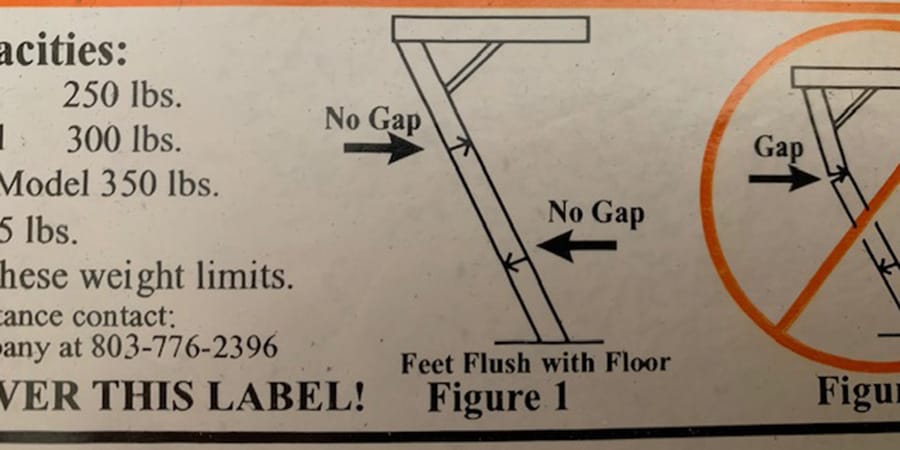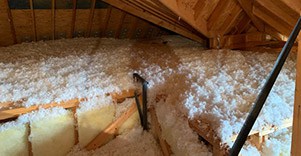
Many homeowners look to attics as a source of additional storage space. Depending on how your attic is designed, you may be unable to use your attic space for storage. Before determining if you can use your attic for storage, we must consider some things.
But before you can use your attic for storage, you’ll need a way to enter and exit the attic safely. Many people opt for installing a pull-down attic door with an access ladder. Attic ladders are convenient and more affordable, but are they safe? Let’s find out.
Attic ladders are safe and reliable, assembled and installed correctly. Most injuries from attic ladders occur from incorrect installation or broken ladder components on old attic ladders.
Call a licensed contractor near you if you don’t have the skills to install an attic ladder. We do not recommend installing a ladder by yourself because you’ll need the help of another person. Also, some carpentry will be required and could cause damage to the home’s structure if done incorrectly.
The attic is usually an underutilized space in a lot of homes. Let’s admit it; it’s sometimes hard to go up and down the house to get an item. However, utilizing this space correctly can make many changes in your living conditions for the better.
You can move general items to the attic and reclaim the space below for other things (office, new room, etc.). Building a sleeping loft or another multi-purpose room is also reasonable if your home’s structure can support it.
An attic ladder is not the easiest to climb (the stairs are better on that part). However, it’s one of the better options for ease of installation and price. The ladder can be installed in under a day with the right tools and measurements. However, safety depends on several factors.

How Safe Are Attic Ladders?
Attic ladders are safe to use when installed correctly and properly maintained. Most ladder accidents are caused by ladder failure due to exceeding the ladder’s weight limit, ladders that are not installed correctly, or not climbing the ladder properly.
The National Safety Council or NSC recommends installing ladders at a three-point contact when withdrawn. Additionally, the attic opening latches should be kept secure and out of reach when unused.
If you install an NSC-approved attic ladder with proper tools and measurements, there should be no problem. Please ensure the attic ladder is secured when raised and that the pull-down door is out of the reach of children.
Here are the most common installation mistakes to avoid:
- Using nails rather than lag screws to hang the attic ladder or door.
- Missing or loose mounting bolts at the hinges. This is common in wood attic ladders.
- The wood ladder is cut too short or improperly angled to make flush contact with the floor.
- The attic ladder falls when the access door is opened.
- Opening the ladder too fast, causing it to snap back.
Considerations For Attic Ladder Safety
It’s better to plan the initial installation than make adjustments after the ladder has been attached. Not only will it be cheaper, but this method will also cost less inconvenience (or none). If you lack carpentry experience, call a building contractor to install your attic ladder.

Inspect Existing Attic Ladders Before Use
Most existing attic ladders are made of wood. In some older homes, the attic ladders are one-piece and constructed on slides, which can be dangerous. This attic ladder is no longer used and is replaced with folding ladders made from wood or aluminum.
The danger surrounding the older wood sliding ladders is that as the attic door is lowered, the ladder can fall if not locked properly. Many of these have broken locking latches. They can also be challenging because the ladders are heavy and do not fold.
Existing folding wood attic ladders often have:
- When extended, missing bolts in the hinges secure the legs. If any hardware is missing, the ladder could fail when climbed on.
- Bent hinges on the attic ladder could prevent the door from opening completely.
- Broken or broken steps that have been repaired are subject to failure, which could cause a fall.
- Ladder legs that have not been cut at an angle prevent the ladder from resting flush on the floor when open.
Measure Ceiling Height And Rough Opening
Before going to the store and buying a random-sized ladder, take the initial measurement to the floor from the ceiling. It’s better to find an adequately sized one than to cut a ladder too long to be usable in your space.
You will need two main measurements when installing a new or replacing an existing attic ladder. These measurements are:
- The width and length of the rough opening. The rough opening is the size of the ceiling’s opening where the attic ladder will be installed. You should measure the rough opening width 3 times from the right, left, and middle sides. Repeat for the rough opening length measurements. Use the smallest measurement to ensure the ladder fits correctly into the opening.
- The ceiling height is the height from the floor to the ceiling. Most homes have ceiling heights of 8 feet; however, some homes can have ceilings as high as 12 feet. Using a plumb bob, measure from the rough opening to the floor. A nylon string with a small weighted object will also work if you don’t have a plumb bob. You can also use a laser measure like the Bosch GLM 20 Blaze 65′ Laser Measure, available at Amazon.com.
Ensure that your ceiling rough opening is at least 22½ to 25 inches by 54 inches so there won’t be any problem during the installation and actual usage.
Know the Types of Attic Ladders Available
You should also consider the type of ladder to install. Different ladders exist, but the most popular options are telescoping, folding, and scissor ladders.
- Folding – this type of ladder functions by folding the joints into two or more sections, creating one downward ladder. It’s way sturdier than telescoping ladders but takes up more space. This is the most common type of attic ladder.
- Scissor – is the easiest to use; scissor ladders are like a rigid string that can be compacted when not used and stretched down. All you have to do is to pull it up and down using the support staff. These ladders are great for small access openings. However, they are more pricey than the traditional folding ladder.
- Telescoping – the ladder steps are stacked when not in use and will expand when pulled down. This is best for cases where compact and sturdy ladders are needed.
Wood vs. Aluminum Attic Ladders: Which is Better?
Are you going to use the ladder regularly? Getting a sturdier and heavier one (ideally made with aluminum). For casual use, a sturdy wooden ladder would be sufficient.
A wood attic ladder is a sturdy attic ladder that has a wider step than most metal ladders. The Louisville Ladder fits a rough opening of 22.5 by 54-inch opening and fits ceiling heights of 7-foot to 10-foot ceiling height. A 25-inch wide option is also available. These wood attic ladders have a 250lb capacity, typical for wood ladders.
An aluminum attic ladder is a heavy-duty attic ladder that is also lightweight, weighing 42.9 lbs. The Louisville Ladder AA2210 Elite Aluminum Attic Ladder fits a rough opening of 22.5 by 54-inch opening and fits ceiling heights of 7-foot to 10-foot ceiling height. A 25-inch wide option is also available. This aluminum attic ladder has a 375lb capacity, which exceeds wood attic ladders.
Need an aluminum attic ladder to fit a 10-foot to 12-foot ceiling? The Louisville Ladder 22.5-inch by 63-inch Aluminum Attic Ladder is a sturdy ladder for taller ceiling heights. This attic ladder fits inside a 22.5 by 63-inch rough opening. It has a slightly lower weight capacity at 350lbs than the above model.
If you don’t have enough ceiling space, you can use the space-saver attic ladders (sturdy enough but don’t have a bulky body). These are retractable ladders that fit inside a small access opening. The Metal Retractable Ladder for lofts and attics is 5 feet to 11-foot. The 8-foot height version weighs 132.3 lbs, considerably heavier than traditional attic ladders.

Know the Attic Ladders Weight Capacity
As mentioned before, measuring the distance between the floor and the ceiling will help you decide on the ladder’s proper length. Consider taking the heaviest person in the house who will use the attic ladder when considering the weight capacity. Remember that you’ll also be toting boxes or totes into the attic, so I suggest adding 25 lbs to the heaviest person’s weight.
In the above examples, we included the weight capacity of the ladder. Wood attic ladders typically weigh 225 to 275 lbs, with 250 lbs as a median average. Aluminum ladders usually have a weight capacity of 350 to 375 lbs.
The Location Of Attic Access Opening Matters
Can ceiling joists, rafters, or roof trusses be cut to install attic access? This is where most homeowners who install attic access ladders themselves mess up.
You can not cut a roof truss, roof rafter, or ceiling joist to install an attic ladder. Cutting into the roof structure can compromise the structural integrity of your home. Do not cut roof trusses. Roof trusses are an engineered product and, once cut, can only be repaired by a structural engineer.
Attic floors are either supported with trusses or floor joists. When the trusses are damaged, they can cause structural instability, compromising your entire roof structure. The best location to install an attic opening is to locate two trusses or ceiling joists and a brace between the trusses or ceiling joists to frame your rough opening.
If you have blown insulation in your attic, you’ll likely need a contractor to construct a raised floor that won’t damage or reduce the insulation’s R-value. It’s not safe to walk across an unfloored area of your attic.
Conclusion
Attic ladders are safe when installed and used correctly. Aluminum ladders tend to have fewer problems than wood attic ladders do. Some older wood ladders can be dangerous if they are damaged.
I think aluminum ladders are safer and better than wood attic ladders because they are lightweight yet have a higher weight capacity. Aluminum ladders also have lock mechanisms on the hinges, making aluminum attic ladders safer than wood attic ladders. Aluminum attic ladders do not require the ladder’s legs to be cut to rest firmly on the floor.






